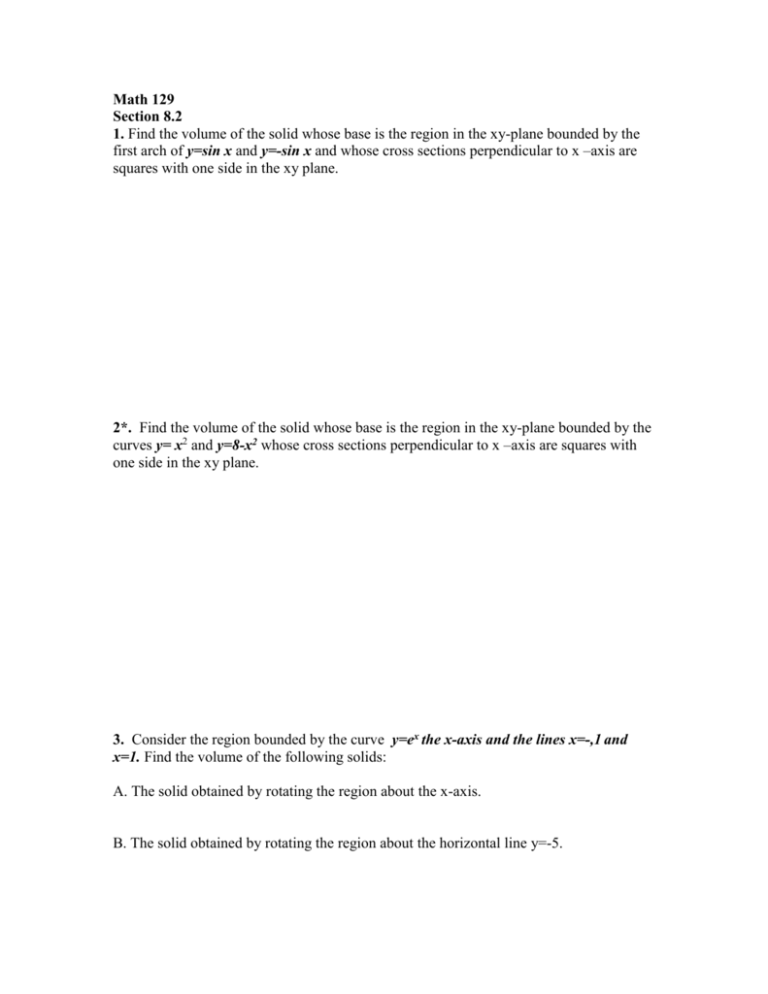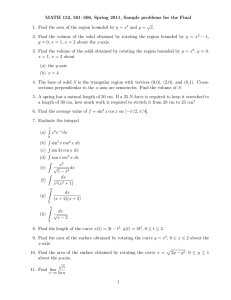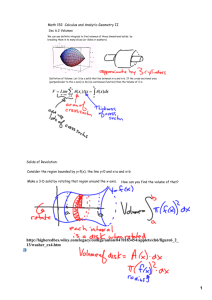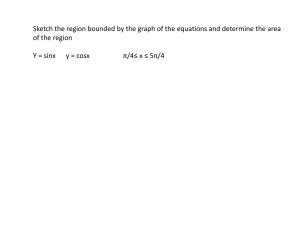Math 129 Section 8.2 1. Find the volume of the solid whose base is
advertisement

Math 129 Section 8.2 1. Find the volume of the solid whose base is the region in the xy-plane bounded by the first arch of y=sin x and y=-sin x and whose cross sections perpendicular to x –axis are squares with one side in the xy plane. 2*. Find the volume of the solid whose base is the region in the xy-plane bounded by the curves y= x2 and y=8-x2 whose cross sections perpendicular to x –axis are squares with one side in the xy plane. 3. Consider the region bounded by the curve y=ex the x-axis and the lines x=-,1 and x=1. Find the volume of the following solids: A. The solid obtained by rotating the region about the x-axis. B. The solid obtained by rotating the region about the horizontal line y=-5. 4*. Find the exact volume of the solid obtained by revolving the region between the graph of y=4-x2 and the x-axis about the line y=5. 5*. The region bounded by y=x3, x=2, and y=-1 is revolved about the line ,y=-8. Sketch the picture of the solid, and find its volume. 6*. Sketch a picture of the solid obtained by revolving the region bounded by the curve y=x4 and the line y=x about the y-axis. Also find the volume of the solid. 7. Recall that the arc length of the function is f(x) from (a,f(a)) to(b,f(b)) is given by b 1 ( f ' ( x)) 2 dx a Use this to approximate the length of the curve y=x3 from (0,0) to (2,8) accurate to one decimal place. The approximation must include a strict lower bound and a strict upper bound. Explain how you determined your answer. 8*. Recall that the arc length of the function is f(x) from (a,f(a)) to(b,f(b)) is given by b 1 ( f ' ( x)) 2 dx a Use this to approximate the length of the curve y=lnx from (1,0) to (4,ln4) accurate to at lest two decimal places. The approximation must include a strict lower bound and a strict upper bound. Explain how you determined your answer. 9. Calculate the exact value of the arc length of the function f ( x) 4 x 2 between the points where x=0 and x=2. 10. Consider the region bounded by the curve y 3 x , the x-axis, and the lines x=0, and x=1. Find the volume of the following solids: A. The solid obtained by rotating this region about the x-axis. B. The solid obtained by rotating this region about the horizontal line y=-2. C. The solid obtained by rotating this region about the vertical line x=1. 11. John starts at the origin and walks along the graph of y=f(x)= x2 at the velocity of 2 10 units per second. A. Write the integral which shows how far John has traveled when he reaches the point where x=a. B. You want to find the x-coordinate of the point John reaches after traveling for 2 seconds. Find an upper and lower estimate, differing by less than 0.2.











